Page 400 of 498
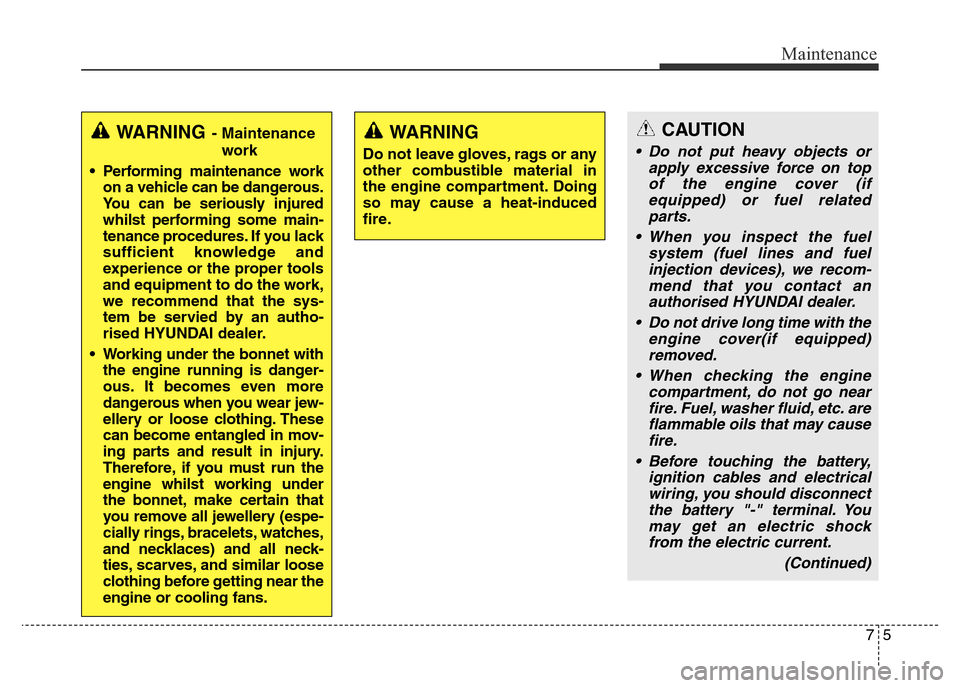
75
Maintenance
WARNING- Maintenance
work
• Performing maintenance work
on a vehicle can be dangerous.
You can be seriously injured
whilst performing some main-
tenance procedures. If you lack
sufficient knowledge and
experience or the proper tools
and equipment to do the work,
we recommend that the sys-
tem be servied by an autho-
rised HYUNDAI dealer.
• Working under the bonnet with
the engine running is danger-
ous. It becomes even more
dangerous when you wear jew-
ellery or loose clothing. These
can become entangled in mov-
ing parts and result in injury.
Therefore, if you must run the
engine whilst working under
the bonnet, make certain that
you remove all jewellery (espe-
cially rings, bracelets, watches,
and necklaces) and all neck-
ties, scarves, and similar loose
clothing before getting near the
engine or cooling fans.WARNING
Do not leave gloves, rags or any
other combustible material in
the engine compartment. Doing
so may cause a heat-induced
fire.
CAUTION
• Do not put heavy objects or
apply excessive force on top
of the engine cover (if
equipped) or fuel related
parts.
• When you inspect the fuel
system (fuel lines and fuel
injection devices), we recom-
mend that you contact an
authorised HYUNDAI dealer.
• Do not drive long time with the
engine cover(if equipped)
removed.
• When checking the engine
compartment, do not go near
fire. Fuel, washer fluid, etc. are
flammable oils that may cause
fire.
• Before touching the battery,
ignition cables and electrical
wiring, you should disconnect
the battery "-" terminal. You
may get an electric shock
from the electric current.
(Continued)
Page 402 of 498
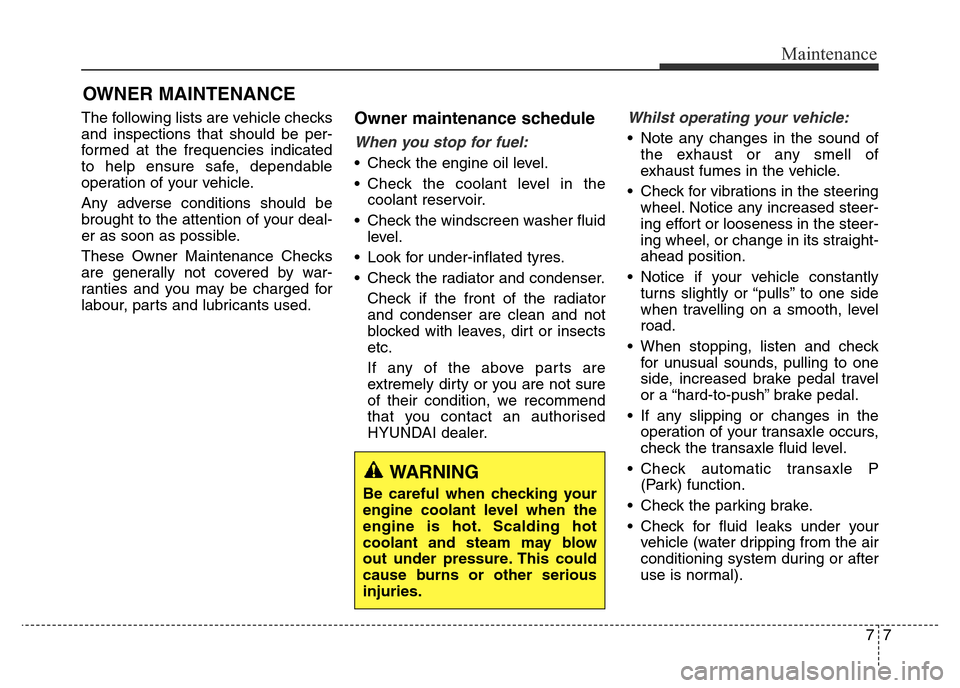
77
Maintenance
OWNER MAINTENANCE
The following lists are vehicle checks
and inspections that should be per-
formed at the frequencies indicated
to help ensure safe, dependable
operation of your vehicle.
Any adverse conditions should be
brought to the attention of your deal-
er as soon as possible.
These Owner Maintenance Checks
are generally not covered by war-
ranties and you may be charged for
labour, parts and lubricants used.Owner maintenance schedule
When you stop for fuel:
• Check the engine oil level.
• Check the coolant level in the
coolant reservoir.
• Check the windscreen washer fluid
level.
• Look for under-inflated tyres.
• Check the radiator and condenser.
Check if the front of the radiator
and condenser are clean and not
blocked with leaves, dirt or insects
etc.
If any of the above parts are
extremely dirty or you are not sure
of their condition, we recommend
that you contact an authorised
HYUNDAI dealer.
Whilst operating your vehicle:
• Note any changes in the sound of
the exhaust or any smell of
exhaust fumes in the vehicle.
• Check for vibrations in the steering
wheel. Notice any increased steer-
ing effort or looseness in the steer-
ing wheel, or change in its straight-
ahead position.
• Notice if your vehicle constantly
turns slightly or “pulls” to one side
when travelling on a smooth, level
road.
• When stopping, listen and check
for unusual sounds, pulling to one
side, increased brake pedal travel
or a “hard-to-push” brake pedal.
• If any slipping or changes in the
operation of your transaxle occurs,
check the transaxle fluid level.
• Check automatic transaxle P
(Park) function.
• Check the parking brake.
• Check for fluid leaks under your
vehicle (water dripping from the air
conditioning system during or after
use is normal).
WARNING
Be careful when checking your
engine coolant level when the
engine is hot. Scalding hot
coolant and steam may blow
out under pressure. This could
cause burns or other serious
injuries.
Page 403 of 498
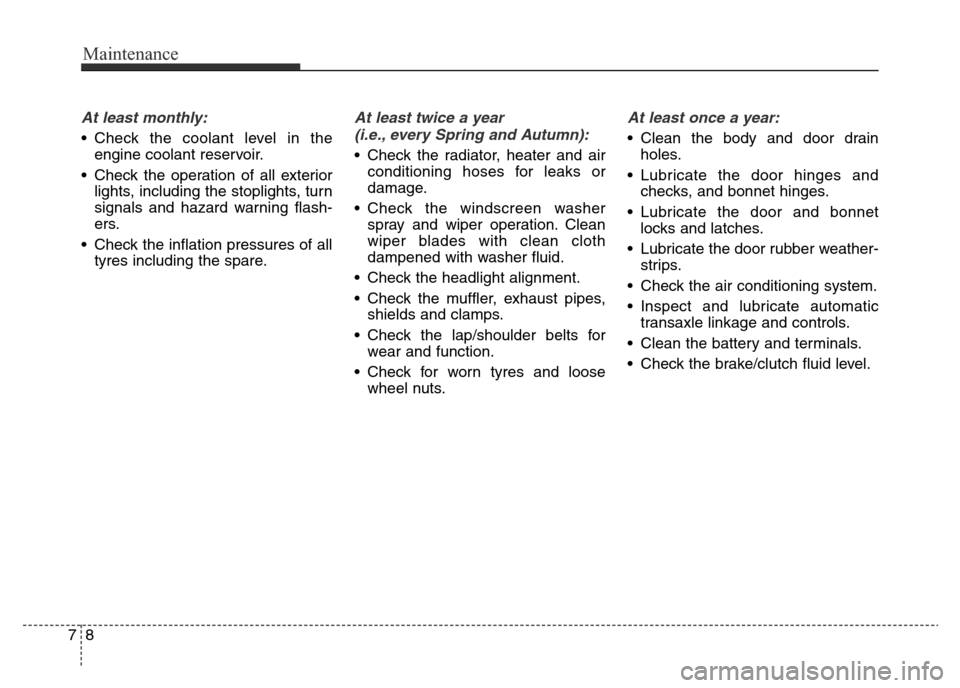
Maintenance
8 7
At least monthly:
• Check the coolant level in the
engine coolant reservoir.
• Check the operation of all exterior
lights, including the stoplights, turn
signals and hazard warning flash-
ers.
• Check the inflation pressures of all
tyres including the spare.
At least twice a year
(i.e., every Spring and Autumn):
• Check the radiator, heater and air
conditioning hoses for leaks or
damage.
• Check the windscreen washer
spray and wiper operation. Clean
wiper blades with clean cloth
dampened with washer fluid.
• Check the headlight alignment.
• Check the muffler, exhaust pipes,
shields and clamps.
• Check the lap/shoulder belts for
wear and function.
• Check for worn tyres and loose
wheel nuts.
At least once a year:
• Clean the body and door drain
holes.
• Lubricate the door hinges and
checks, and bonnet hinges.
• Lubricate the door and bonnet
locks and latches.
• Lubricate the door rubber weather-
strips.
• Check the air conditioning system.
• Inspect and lubricate automatic
transaxle linkage and controls.
• Clean the battery and terminals.
• Check the brake/clutch fluid level.
Page 405 of 498
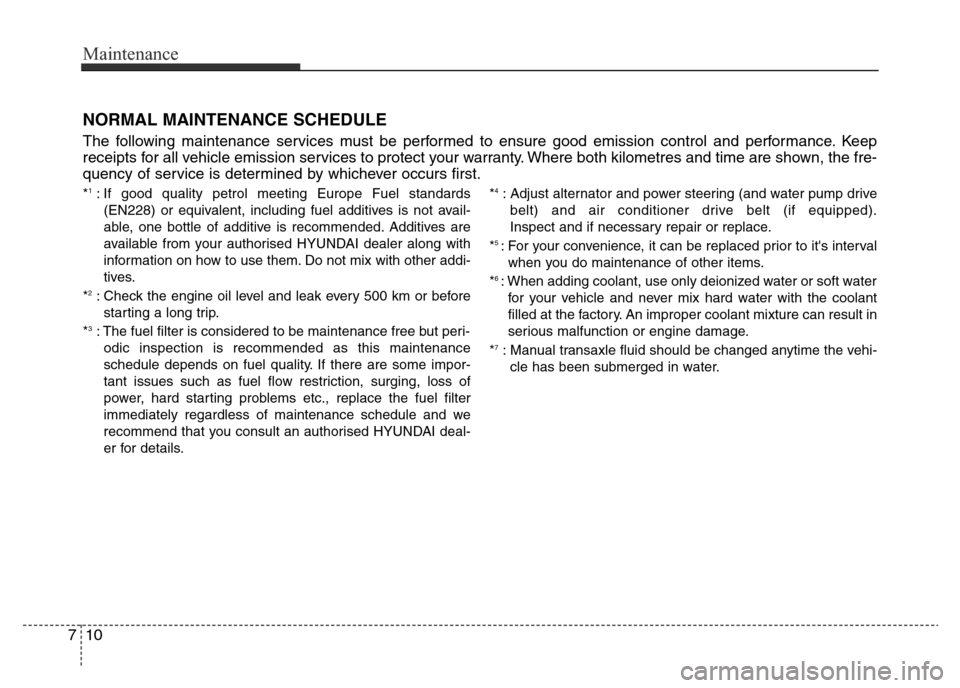
Maintenance
10 7
NORMAL MAINTENANCE SCHEDULE
The following maintenance services must be performed to ensure good emission control and performance. Keep
receipts for all vehicle emission services to protect your warranty. Where both kilometres and time are shown, the fre-
quency of service is determined by whichever occurs first.
*1: If good quality petrol meeting Europe Fuel standards
(EN228) or equivalent, including fuel additives is not avail-
able, one bottle of additive is recommended. Additives are
available from your authorised HYUNDAI dealer along with
information on how to use them. Do not mix with other addi-
tives.
*
2: Check the engine oil level and leak every 500 km or before
starting a long trip.
*
3: The fuel filter is considered to be maintenance free but peri-
odic inspection is recommended as this maintenance
schedule depends on fuel quality. If there are some impor-
tant issues such as fuel flow restriction, surging, loss of
power, hard starting problems etc., replace the fuel filter
immediately regardless of maintenance schedule and we
recommend that you consult an authorised HYUNDAI deal-
er for details.*
4: Adjust alternator and power steering (and water pump drive
belt) and air conditioner drive belt (if equipped).
Inspect and if necessary repair or replace.
*
5 : For your convenience, it can be replaced prior to it's interval
when you do maintenance of other items.
*
6 : When adding coolant, use only deionized water or soft water
for your vehicle and never mix hard water with the coolant
filled at the factory. An improper coolant mixture can result in
serious malfunction or engine damage.
*
7: Manual transaxle fluid should be changed anytime the vehi-
cle has been submerged in water.
Page 411 of 498
Maintenance
16 7
NORMAL MAINTENANCE SCHEDULE (CONT.)
(Continued)
❑ Inspect tyre (pressure & tread wear)
❑ Inspect manual transaxle fluid (if equipped) *8
❑ Inspect vapour hose and fuel filler cap
❑ Inspect vacuum hose
❑ Inspect cooling system
(At first, 60,000 km or 48months
after that, every 30,000 km or 24months)
❑ Replace climate control air filter (if equipped)
❑ Replace engine oil and filter *2
❑ Replace fuel filter *3
❑ Replace fuel tank air filter
❑ Replace spark plugs (Every 160,000 km)
❑ Replace coolant *5 *6
(At first, 210,000 km or 120months
after that, every 30,000 km or 24months)
No check, No service required
❑Automatic transaxle fluid (if equipped)
❈Inspect : Inspect and if necessary, adjust, correct, clean or
replace.
Page 414 of 498
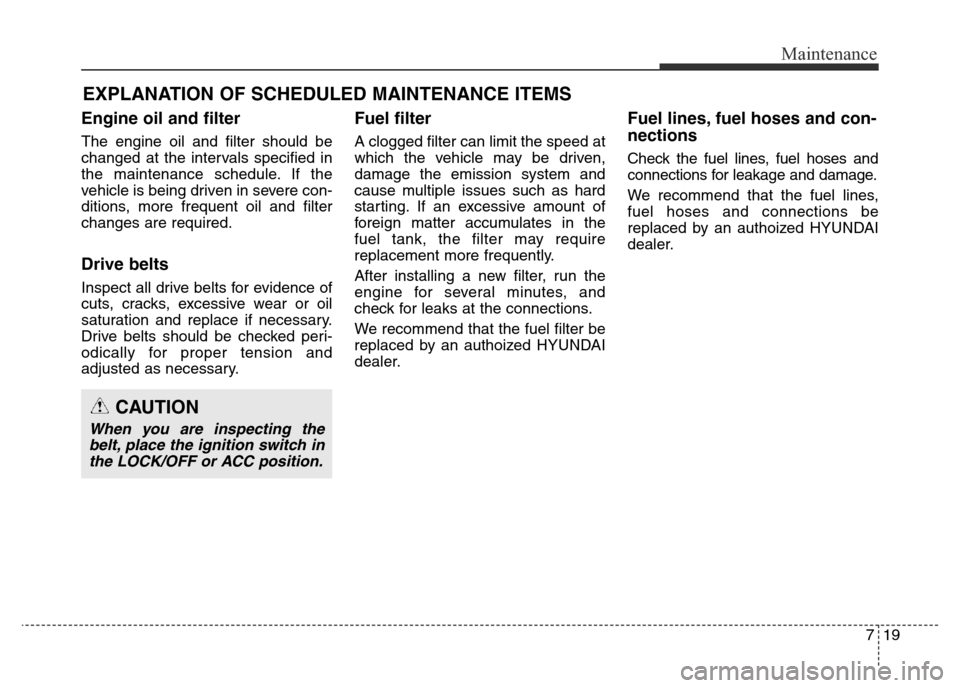
719
Maintenance
EXPLANATION OF SCHEDULED MAINTENANCE ITEMS
Engine oil and filter
The engine oil and filter should be
changed at the intervals specified in
the maintenance schedule. If the
vehicle is being driven in severe con-
ditions, more frequent oil and filter
changes are required.
Drive belts
Inspect all drive belts for evidence of
cuts, cracks, excessive wear or oil
saturation and replace if necessary.
Drive belts should be checked peri-
odically for proper tension and
adjusted as necessary.
Fuel filter
A clogged filter can limit the speed at
which the vehicle may be driven,
damage the emission system and
cause multiple issues such as hard
starting. If an excessive amount of
foreign matter accumulates in the
fuel tank, the filter may require
replacement more frequently.
After installing a new filter, run the
engine for several minutes, and
check for leaks at the connections.
We recommend that the fuel filter be
replaced by an authoized HYUNDAI
dealer.
Fuel lines, fuel hoses and con-
nections
Check the fuel lines, fuel hoses and
connections for leakage and damage.
We recommend that the fuel lines,
fuel hoses and connections be
replaced by an authoized HYUNDAI
dealer.
CAUTION
When you are inspecting the
belt, place the ignition switch in
the LOCK/OFF or ACC position.
Page 417 of 498
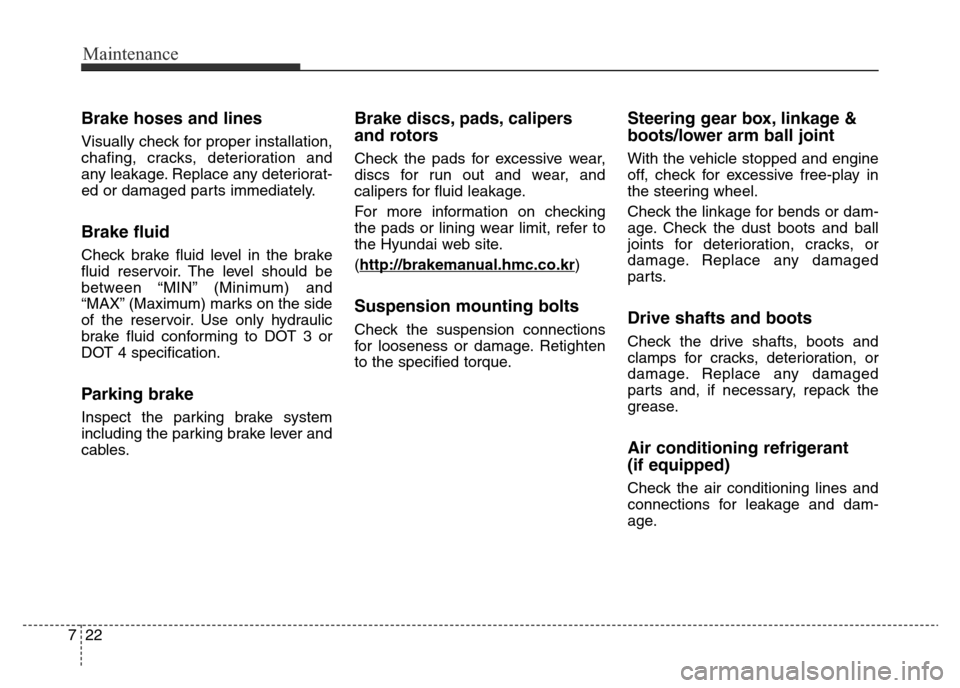
Maintenance
22 7
Brake hoses and lines
Visually check for proper installation,
chafing, cracks, deterioration and
any leakage. Replace any deteriorat-
ed or damaged parts immediately.
Brake fluid
Check brake fluid level in the brake
fluid reservoir. The level should be
between “MIN” (Minimum) and
“MAX” (Maximum) marks on the side
of the reservoir. Use only hydraulic
brake fluid conforming to DOT 3 or
DOT 4 specification.
Parking brake
Inspect the parking brake system
including the parking brake lever and
cables.
Brake discs, pads, calipers
and rotors
Check the pads for excessive wear,
discs for run out and wear, and
calipers for fluid leakage.
For more information on checking
the pads or lining wear limit, refer to
the Hyundai web site.
(http://brakeman
ual.hmc.co.kr)
Suspension mounting bolts
Check the suspension connections
for looseness or damage. Retighten
to the specified torque.
Steering gear box, linkage &
boots/lower arm ball joint
With the vehicle stopped and engine
off, check for excessive free-play in
the steering wheel.
Check the linkage for bends or dam-
age. Check the dust boots and ball
joints for deterioration, cracks, or
damage. Replace any damaged
parts.
Drive shafts and boots
Check the drive shafts, boots and
clamps for cracks, deterioration, or
damage. Replace any damaged
parts and, if necessary, repack the
grease.
Air conditioning refrigerant
(if equipped)
Check the air conditioning lines and
connections for leakage and dam-
age.
Page 418 of 498
723
Maintenance
ENGINE OIL
Checking the engine oil level
1. Ensure the vehicle is on level
ground.
2. Start the engine and allow it to
reach normal operating tempera-
ture.
3. Turn the engine off and wait for a
few minutes (about 5 minutes) for
the oil to return to the oil pan.
4. Pull the dipstick out, wipe it clean,
and reinsert it fully.5. Pull the dipstick out again and
check the level. The level should
be between F (Full) and L (Low).
WARNING - Radiator
hose
Be very careful not to touch the
radiator hose when checking or
adding the engine oil as it may
be hot enough to burn you.CAUTION
• Do not spill engine oil, when
adding or changing engine oil.
If you spill engine oil in the
engine compartment, wipe it
off immediately.
• When you wipe the oil level
gauge, you should wipe it with
a clean cloth. When mixed
with debris, it can cause
engine damage.
OMD071002L